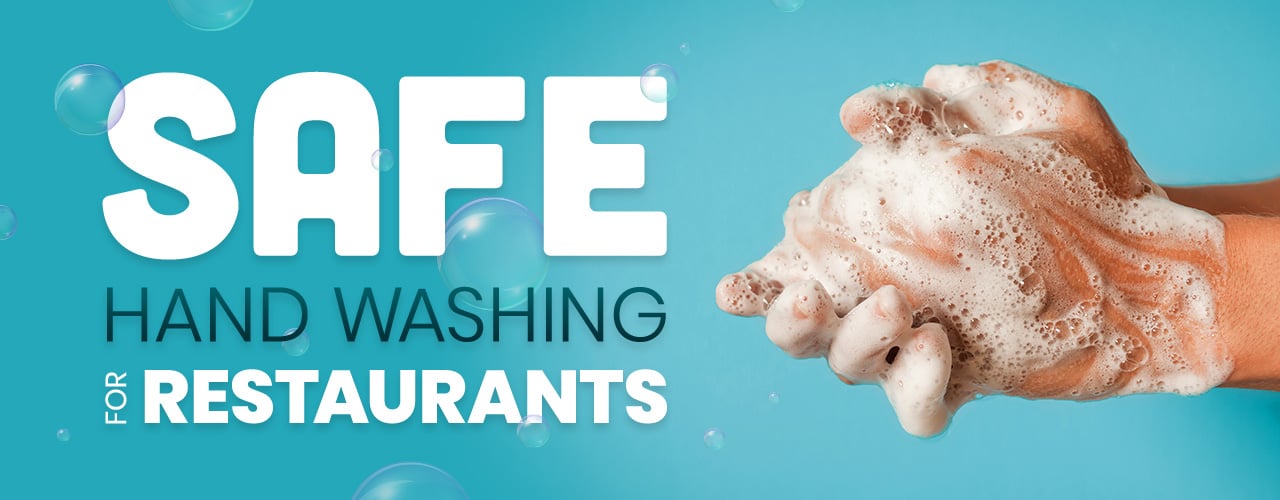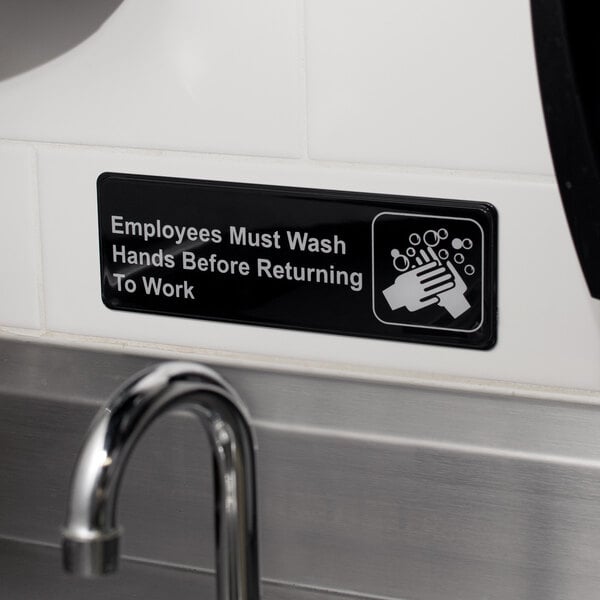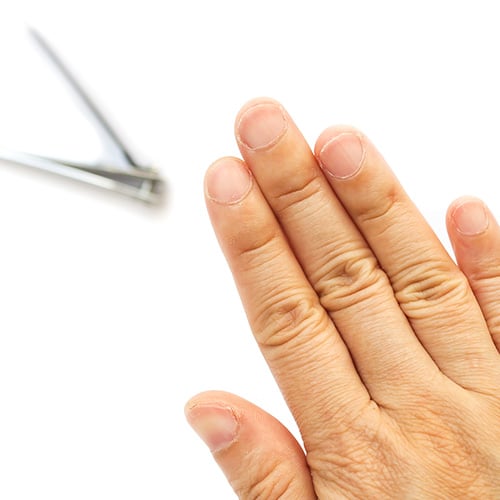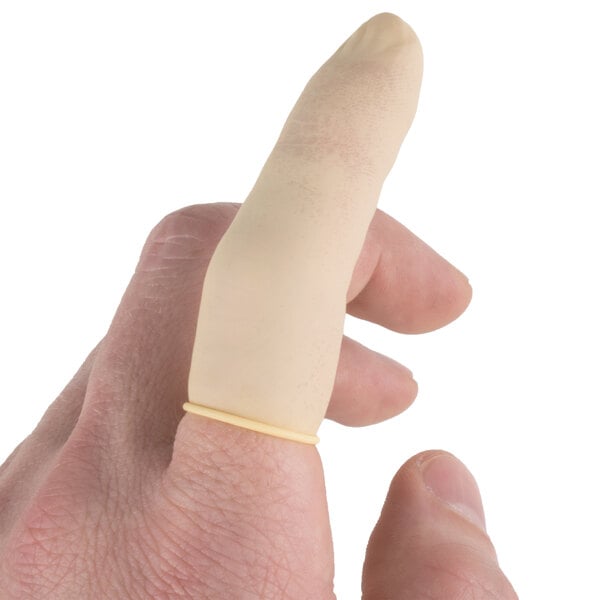
Hand washing is one of the most important aspects of a restaurant’s food safety program. Without a hand washing policy in place or a strong focus on consistent training, it’s difficult to make sure your staff is following protocols. Keep reading to learn about the basics of hand washing and how to promote hand hygiene in your restaurant.
How to Wash Your Hands the Right Way
Check out our video for a step-by-step demonstation of proper hand washing:
Unwashed hands provide a vehicle for germs to travel throughout your business, and any surface or item your employees touch could become contaminated. The hand washing spotlight is often put on the kitchen staff, but hand washing hygiene isn't just a requirement for food handlers. Front-of-house employees also touch surfaces that can become sources of cross-contamination, like drinking glasses and flatware.
Because the pathogens that cause foodborne illness are too small to see, hand washing remains one of the safest methods to prevent these microorganisms from spreading. Clean hands are also a good defense against COVID-19, an airborne virus that could live on surfaces like menus or door handles long enough to be transmitted from person to person. Per the CDC, this is not considered the primary way the coronavirus spreads, but a good hand washing policy is a crucial part of protecting against infection.
Where Are You Allowed to Wash Your Hands?

Hands must be washed at designated hand washing stations that are stocked with approved hand washing soap and paper towels. The hand sink must provide warm running water that’s adjustable to at least 100 degrees Fahrenheit, and each hand washing station should be identified by a sign.
These requirements are meant to prevent employees from washing their hands at the wrong sink. Commercial kitchens have multiple sinks for different uses, but not all of them are suited for hand washing. For instance, a utility sink will not have paper towels or hand soap nearby and can actually be a source of contamination from dirty mop water. A pot filler sink may not have water hot enough to kill germs. If a health inspector observes a staff member washing their hands at one of these sinks instead of a hand washing sink, it could result in a health code violation.
Hand Washing Sink Regulations
Commercial kitchen hand sink requirements may vary depending on your local regulatory authority, but this list can be used as a general guide when creating your hand washing stations. Stocked handwashing stations must have the following:
- Location - Hand washing sinks should be located in convenient locations throughout your restaurant, including the front-of-house and bar areas
- Usage - Designated hand washing sinks cannot be used for any other purpose besides washing hands
- Hand soap - Approved hand washing soap must be provided
- Hand drying - Paper towels or hand dryers should be wall mounted within reach
- Water lines - The sink should provide hot and cold running water
- Water temperature - Hot and cold water should be adjustable to reach at least 100 degrees Fahrenheit
- Touchless faucets - Touchless faucets must run for at least 15 seconds
- Hand washing sign - Hand washing sinks should be identified by a hand washing compliance sign
How to Wash Your Hands
Operators can make a big mistake by assuming their employees know how to wash their hands the right way. It seems like a simple task, but there's actually a technique that can make hand washing more effective. Demonstrate the following hand washing steps to your staff:
- Use warm running water to wet hands and forearms
- Apply soap and rub hands together to build up a lather
- Scrub hands and arms for 20 seconds (include fingertips, between fingers, and under fingernails)
- Rinse thoroughly with warm water
- Dry hands and arms with a clean paper towel or hand dryer
- After washing, use a paper towel to turn off the faucet
You can encourage your staff to remember all the hand washing steps by posting reminders at each hand sink. A poster that lists out all the steps and includes images can be a helpful visual tool.
When Should Food Handlers Wash Their Hands?
Frequent hand washing is even more successful when it’s performed before and after certain activities. Most everyone knows it’s required to wash hands after using the restroom, but there are some not-so-obvious tasks that are also notorious for spreading germs, like handling money or touching your phone. Make sure your staff knows when to wash their hands by following this guide:
Hands must be washed before beginning the following tasks:
- Preparing food
- Handling clean dishes or utensils
- Putting on clean, single-use gloves
- Changing tasks

Hands must be washed after performing the following actions:
- Using the restroom
- Touching your face, hair, or clothing
- Handling soiled items or taking out trash
- Touching raw meat, seafood, or poultry
- Using cleaning chemicals
- Handling money
- Using the POS system
- Answering the land-line phone
- Touching electronic devices like mobile phones
- Eating, drinking, or smoking
- Touching any surface that might contaminate hands
- Removing soiled, single-use gloves
- Changing tasks
Note that the correct way to wear disposable gloves is to wash hands before putting them on and after taking them off. This improves both the effectiveness of the gloves and prevents any chances of contamination.
What Is Hand Care?

Hand care goes beyond hand washing alone and extends to maintaining the personal hygiene of hands and nails. Restaurant employees are responsible for practicing good hand care to improve the effectiveness of hand washing policies.
Hand Hygiene Guidelines
Just like the guidelines surrounding clean uniforms and other forms of personal hygiene in the workplace, there are requirements for practicing hand care.
- Fingernail length - Keep fingernails trimmed and clean. Long nails are hard to get completely clean and provide a hiding place for germs. They can also rip gloves or chip off into food, becoming a physical contaminant.
- Fake nails - Foodservice employees should avoid wearing fake nails. They are hard to keep clean and can break off into food.
- Nail polish - To practice good hand care, employees should not wear nail polish. Dirt is hard to see underneath painted nails, and nail polish can flake off into food.
- Jewelry - Jewelry like rings and bracelets should not be worn while working in a restaurant. Dirt and contaminants can find their way beneath or inside of the jewelry. A single plain wedding band is usually allowed but all other rings should be removed during the shift.
Protecting Open or Infected Wounds

Accidents can happen very easily in a kitchen filled with sharp knives and hot pans. If an employee sustains an injury to their hands or arms, it's important to care for the wound properly. Open or infected wounds can become a source of contamination to food or food-contact surfaces. Follow these recommendations to protect injuries and prevent cross-contamination:
- Wound on the hand or wrist - Cover the wound with a water-resistant bandage or finger cot. Wear a disposable glove over top of the bandage.
- Wound on the arm - Cover the wound completely with a water-resistant bandage.
What Is a Finger Cot?
A finger cot, or finger glove, is a latex sheath that completely covers a single finger and protects a cut or wound. Foodservice employees commonly use finger cots to prevent fluids from a wound from becoming a source of contamination.
As an operator, it's your job to set the tone regarding your hand washing policy. Never assume that a new employee already knows the when, where, and how of hand washing. Make your requirements very clear from the start, provide helpful reminders, and monitor your staff to ensure they are meeting your expectations.





